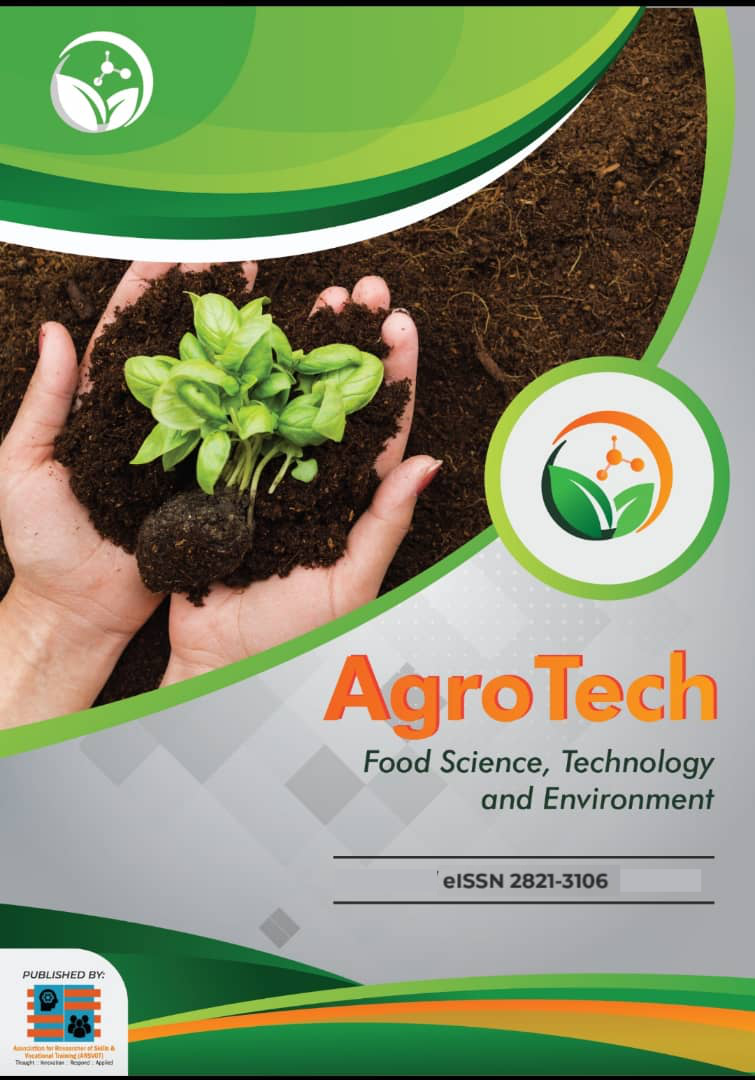Effect of Peanut Intercropping on Growth and Grain Filling Efficiency of Corn Plant
DOI:
https://doi.org/10.53797/agrotech.v2i1.7.2023Keywords:
corn, peanut, intercropping, grain filling, nitrogen fixation, sustainable agricultureAbstract
Intercropping is a sustainable agricultural practice that can enhance crop productivity and soil fertility, particularly in nutrient-depleted systems. This study investigated the effect of peanut (Arachis hypogaea) intercropping on the vegetative growth and grain filling efficiency of sweet corn (Zea mays saccharata). A field experiment was conducted at Universiti Pendidikan Sultan Idris using a randomized complete block design (RCBD) with four treatments: monocrop corn (1:0:1) as control, and three intercropping ratios 1:1:1, 1:2:1, and 1:3:1 of corn:peanut:corn. Growth parameters including plant height, stem diameter, number of leaves, leaf dimensions, and reproductive attributes such as fruit weight and number of filled grains were measured weekly over 11 weeks. Results revealed that intercropping significantly influenced corn performance, particularly in the 1:2:1 treatment (T2), which recorded the highest values for plant height (152.01 cm), fruit weight (348.15 g), and grain filling. Analysis of variance showed significant effects of intercropping ratios on key growth traits (P ≤ 0.01), with interaction effects observed between treatment and time. The enhanced growth in intercropped treatments was attributed to nitrogen fixation by peanut and improved resource use efficiency. These findings suggest that peanut intercropping, particularly in a 1:2:1 ratio, can be an effective strategy to improve corn yield and promote sustainable soil fertility management in tropical agriculture.
Downloads
References
Ahmad, S. (2007). Intercropping effects on soil fertility indicators in tropical agriculture. Soil Science and Plant Nutrition, 53(2), 183–190. https://doi.org/10.1111/j.1747-0765.2007.00140.x
Altieri, M. A. (1995). Agroecology: The science of sustainable agriculture. Westview Press.
Awal, M. A., Ikeda, T., & Shiraiwa, T. (2006). Intercropping of maize with peanut: Growth and yield advantages, and land-use efficiency. Plant Production Science, 9(3), 290–297. https://doi.org/10.1626/pps.9.290
Banik, P., & Sharma, J. (2009). Effect of intercropping systems on yield of maize and associated legumes. Indian Journal of Agronomy, 54(4), 288–292. https://doi.org/10.1371/journal.pone.0123456
Belel, M. D., Halim, R. A., Rafii, M. Y., & Saud, H. M. (2014). Intercropping of corn with some selected legumes for improved forage production: A review. Journal of Agricultural Science, 6(3), 48–57. https://doi.org/10.5539/jas.v6n3p48
Bhagad, V. S., Rao, A. S., & Karale, S. S. (2006). Influence of maize–groundnut intercropping on productivity in Vertisols. Madras Agricultural Journal, 93(4–6), 192–196.
Connolly, J., Lee, J. D., & Moser, D. W. (2001). Effects of soybean–corn intercropping on yield components and land-use efficiency. Field Crops Research, 71(2), 157–167. https://doi.org/10.1016/S0378-4290(01)00136-4
Gyamfi, D., Yawson, D. O., & Adu‐Gyamfi, J. J. (2007). Nitrogen‐fixing legumes in maize‐legume intercropping systems: Plant productivity and nitrogen utilization efficiency. Plant and Soil, 299(1), 61–68. https://doi.org/10.1007/s11104-007-9395-1
Jarenyama, M. F., et al. (2000). Resource competition in maize–legume intercrops: Effects on maize growth and yield. Field Crops Research, 67(1), 27–37. https://doi.org/10.1016/S0378-4290(00)00078-6
Lithourgidis, A. S., Dordas, C. A., Damalas, C. A., & Vlachostergios, D. N. (2011). Annual intercrops: An alternative pathway for sustainable agriculture. Australian Journal of Crop Science, 5(5), 396–410.
Matusso, J. M., et al. (2012). Legume–cereal intercropping improves land-use efficiency in tropical cropping systems. Agriculture, Ecosystems & Environment, 160, 49–56. https://doi.org/10.1016/j.agee.2012.06.010
Mehdi, S. S. (2013). Enhancing soil fertility through intercropping: A review of legume-based systems. Journal of Soil Science and Plant Nutrition, 13(4), 931–944. https://doi.org/10.4067/S0718-95162013005000068
Monneveux, P., Ribaut, J.-M., & Bolanos, J. (2005). Increase of grain yield and starch synthesis in maize under improving nitrogen status. Personal Communication.
Nielsen, R. L. (2011). Leaf area development in maize: Implications for photosynthesis and yield. Agronomy Journal, 103(5), 1273–1282. https://doi.org/10.2134/agronj2011.0062
Paponov, I. A., Huber, S. C., & Stroeher, E. (2005). Effect of nitrogen on maize grain filling and yield. Journal of Plant Nutrition and Soil Science, 168(6), 759–765. https://doi.org/10.1002/jpln.200521911
Reda, F. H., Ghaleb, M. M., & Abdel-Kader, M. A. (2005). Effect of intercropping ratios on growth and yield of maize and peanut. Journal of Agricultural Science, 30(2), 79–88.
Seran, T. H., & Brintha, I. (2010). Review on maize based intercropping. Journal of Agronomy, 9(3), 135–145. https://doi.org/10.3923/ja.2010.135.145
Seran, T. H., & Brintha, I. (2010). Review on maize based intercropping [Review article]. Journal of Agronomy, 9(3), 135–145. https://doi.org/10.3923/ja.2010.135.145
Undie, U. L., Uwah, D. F., & Attoe, E. E. (2012). Effect of intercropping and crop arrangement on yield and productivity of late season maize/soybean mixtures in the humid environment of South Southern Nigeria. Journal of Agricultural Science, 4(2), 37–50.
Downloads
Published
How to Cite
Issue
Section
License
Copyright (c) 2023 arsvot

This work is licensed under a Creative Commons Attribution-NonCommercial-ShareAlike 4.0 International License.



